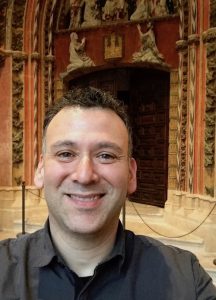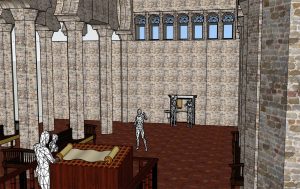Podcast: Play in new window | Download
Subscribe: Spotify | Email | RSS | More

Roger Martinez, associate professor in the Department of History at the University of Colorado Colorado Springs, is using immersive virtual reality tools to recreate worlds that no longer exist. The Immersive Global Middle Ages project, funded by a grant from the National Endowment for the Humanities Institute for Advanced Topics in the Digital Humanities, will transport viewers back in time to experience the fifth through 15th centuries.
- Five-hundred to 1500 is generally what is considered the European Middle Ages. It encapsulates the space between what was before and what is after.
- Fifteen-hundred hearkens the Early Modern Age, an outcome of the Renaissance, which is this point where new ideas are taking hold, new experimentations with culture and knowledge.
- Violence was prevalent during the Middle Ages because of the fracture of the old Roman world of the legal systems, and the application of law.
- Middle Ages period reflects a local life in that your community is where you live, and to leave the city that you live in, or the region you live in invites banditry that you walk out of your space and you’re no longer protected.
- Revisiting the Middle Ages in today’s society, we’re undergoing a repaganization of global society, meaning there’s less Christianization in the world and more acceptance of different dynamics.
- Martinez’s work on the Immersive Middle Ages project will cover two years, with the first virtual exploration becoming available this summer.
-

The Synagogue of Plasencia Virtual Environment (click to enlarge) In many respects, we already have been experiencing immersive technology for 100 years, it’s called the movies.
- How virtual technology works and the aim of taking viewers/visitors back to the Middle Ages — adding a new kind of way of experiencing that completeness of another world.
- Broadening the view to understand what was happening across the globe during the Global Middle Ages. Other civilizations that were thriving, and deeply involved with trade.
- Seeking out academics around the world that are doing research on different civilizations and asking them to join for the next two years to talk about their research, to from the global perspective.
- The technology being used that will help take a step back to the Middle Ages is SketchUp Pro is a software made by Trimble.
- Coming is this summer 2022, the first set of scholars, about 14 folks, will descend on Colorado Springs where they will start to showcase the beginnings of their first models.
- Remember those super-cool dioramas behind glass in the museums? This virtual reality will be similar, except participants will be standing inside it.
- Participants will be able to stand alongside other people who are there at that time.
- Viewers will be able to download the content from sites such as Steam.
- The project is part of the NEH’s Global Middle Ages Institute collaboration. Collectively Martinez and his colleague Dr. Lynn Ramey at Vanderbilt University, a medievalist as well, benefited from this opportunity to create an institute around a more inclusive Global Middle Ages and technology.
- Also collaborating is alongside of them are scholars such as Geraldine Heng from the University of Texas at Austin.
- Martinez and his students have developed a model of a medieval city of Palencia, Spain, and are populating it with the synagogue, the cathedral, houses, different dioramas of different individuals.
- Meet Yosef Castano. Yosef, which is Joseph in the early 1400s, lived in the Jewish part of town and Christian knights lived in the same region. Yosef had an important job as a chainmail maker, and a plate armorer. This shows something completely new about the Middle Ages –coexistence and collaboration.
- Same with the Muslim wine-makers. Did they partake of their goods? We’ll never know.
- UCCS has a vibrant Master of History program; one of the largest ones in the region. Approximately 70 students work on a global master of arts throughout the world.
- How UCCS humanities graduates are combining the robustness of intellectual life and rigor of the humanities, which is about intensive investigation.
- Be sure to check the resources below to find ways to follow the progress of the UCCS Immersive Global Middle Ages project!
Resources
- UCCS Immersive Global Middle Ages
- Twitter: https://twitter.com/immersive_GMA
- NEH’s Global Middle Ages Institute collaboration
- National Endowment for the Humanities
- UCCS Master of History program
- CU on the Air: Exploring and learning from coexistence in Medieval Spain, June 2018
- University of Colorado Colorado Springs
- Technology in use:
